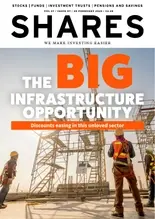
THIS IS AN ADVERTISING FEATURE
By Viktor Szabó, Investment Manager, Aberdeen Latin American Income Fund Limited
-The economic impact of the pandemic for Latin America has been dire, but not as bad as for some global peers
-There are encouraging signs of recovery from key sectors of the economy
-The corporate sector has shown its resilience
Latin America may be at a turning point. After a difficult period for the region, where many countries have struggled to contain the virus, a number of factors are coming together to create a better outlook. These include a changing political climate in the US, fiscal and monetary support and stronger prospects for corporate earnings.
There can be little doubt that the region has been hard hit by the pandemic. Case levels and mortality rates have been persistently high. The economic impact has been dire, reflected in some shocking figures - Brazil's economy, for example, contracted 9.7% in the second quarter over the previous quarter, its worst performance on record.
Nevertheless, these figures are no worse and, in some cases, considerably better than global peers. For example, US GDP declined by 31.4% over the second quarter. Equally, it is clear that the region is in the early stages of a recovery. Industrial production figures are improving, as are retail sales. Remittances have held up well. The services sector is likely to lag because it incorporates the under-pressure leisure and travel sectors, but here too there are early signs of improvement as mobility increases.
There is reason to believe that this recovery can continue. Inflation remains benign, which is allowing central banks to keep rates low. Chile and Peru have already taken their rates to 0.5% and 0.25% respectively. Brazil’s benchmark interest rate is its lowest ever - 3% per year. Mexico’s base rate is higher at 4.25%, but this is 4% below its level in 2019.
Fiscal stimulus is also in place to support the economy. Although Latin American countries don’t always have deep pockets to shore up households and businesses, there have been creative options to help credit growth. Small and medium-sized enterprises across the region have received preferential loans. At R$322 billion and 4.5% of GDP, Brazil’s emergency aid program has benefited more than 50 million people. This is typical of the type of stimulus package across the region.
These measures should act to support corporate earnings. As has been the case across the rest of the world, the impact of the pandemic on earnings has largely been determined by sector - tourism and leisure have been hit hard, while technology has remained robust. However, when we look across the holdings in the Aberdeen Latin American Income fund, even among companies that might seem vulnerable the impact on earnings has not been as catastrophic as it might first have appeared.
For example, we held two airport operators in Mexico, which saw their businesses coming to a complete stop. Both had enough cash to continue operating, but also, importantly, the subsidies received from the government took account of the level of traffic. This means they will ultimately be compensated for the period of time they couldn’t operate. Even in this extreme case, the situation has not been as bad as expected.
At the opposite end of the spectrum were companies such as Mercado Libre, the largest e commerce platform in Latin America, which saw business volumes soar in this period. It was a similar picture at companies such as Globant, which is involved in digital services and helping companies achieve digital transformation.
Overall, we have found companies are recovering more quickly than originally expected. Companies in the portfolio reacted swiftly to events and took matters in their own hands. They worked hard to retain their employees and put themselves in a position to be ready for recovery. Companies with better access to funding were quite quick to raise more capital to protect against any liquidity crunch. Many have taken steps to reduce their expenses where possible and strengthen their balance sheets.
We believe this should put them in a strong position for the rebound when it comes. We prefer to invest in the market leaders and believe many may be able to gain market share in this environment as less well-managed rivals go bust.
There is a final consideration that, to our mind, may help support Latin America’s recovery and that is a change in tone from the US. However much many Latin American leaders may wish it were otherwise, the fate of many countries in the region is still tied to that of the US. President Trump’s term has been characterised by increasing protectionism and he has been notably unfavourable to Latin American countries, particularly Mexico.
Joe Biden has already started to extend an olive branch to Latin America, offering partnership to fight coronavirus, promote green investment and deepen economic ties, according to recent reports. This may prove important in Latin America’s recovery.
While this has been a tough period for Latin America, we see plenty of green shoots to encourage investors. We believe Latin American companies will be quick out of the blocks on recovery.
Important information
Risk factors you should consider prior to investing:
-The value of investments and the income from them can fall and investors may get back less than the amount invested.
-Past performance is not a guide to future results.
-Investment in the Company may not be appropriate for investors who plan to withdraw their money within 5 years.
-The Company may borrow to finance further investment (gearing). The use of gearing is likely to lead to volatility in the Net Asset Value (NAV) meaning that any movement in the value of the company’s assets will result in a magnified movement in the NAV.
-The Company may accumulate investment positions which represent more than normal trading volumes which may make it difficult to realise investments and may lead to volatility in the market price of the Company’s shares.
-The Company may charge expenses to capital which may erode the capital value of the investment.
-Derivatives may be used, subject to restrictions set out for the Company, in order to manage risk and generate income. The market in derivatives can be volatile and there is a higher than average risk of loss.
-Movements in exchange rates will impact on both the level of income received and the capital value of your investment.
-There is no guarantee that the market price of the Company’s shares will fully reflect their underlying Net Asset Value.
-As with all stock exchange investments the value of the Company’s shares purchased will immediately fall by the difference between the
-buying and selling prices, the bid-offer spread. If trading volumes fall, the bid-offer spread can widen.
-The Company invests in emerging markets which tend to be more volatile than mature markets and the value of your investment could move sharply up or down.
-Certain trusts may seek to invest in higher yielding securities such as bonds, which are subject to credit risk, market price risk and interest rate risk. Unlike income from a single bond, the level of income from an investment trust is not fixed and may fluctuate.
-With funds investing in bonds there is a risk that interest rate fluctuations could affect the capital value of investments. Where long term interest rates rise, the capital value of shares is likely to fall, and vice versa. In addition to the interest rate risk, bond investments are also exposed to credit risk reflecting the ability of the borrower (i.e. bond issuer) to meet its obligations (i.e. pay the interest on a bond and return the capital on the redemption date). The risk of this happening is usually higher with bonds classified as ‘sub-investment grade’. These may produce a higher level of income but at a higher risk than investments in ‘investment grade’ bonds. In turn, this may have an adverse impact on funds that invest in such bonds.
-Yields are estimated figures and may fluctuate, there are no guarantees that future dividends with match or exceed historic dividends and certain investors may be subject to further tax on dividends.
Find out more at www.latamincome.co.uk or by registering for updates.
Follow us on social media here: Twitter or LinkedIn.
GB-171120-134294-2



